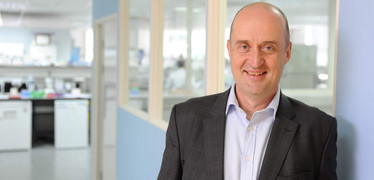Solutions in… Human Antibodies
John McCafferty, CEO of IONTAS, explains how his company’s work in mammalian cells could bring biopharmaceuticals to market faster.

John McCafferty, CEO of IONTAS.
As co-founder of Cambridge Antibody Technology, John McCafferty is no stranger to starting a business. The company was once dubbed the “jewel in the crown” of the British biotechnology industry for its work on antibody therapeutics (1). As of 2012, he has transitioned back into industry from academia, and currently serves as CEO of IONTAS, which focuses on developing technology for protein-based drug discovery.
Why return to industry?
Without a shadow of a doubt, Cambridge Antibody Technology played a pivotal role in my career. The company was a spin out, founded by David Chiswell, Director of Nabriva, and Greg Winter, founder of Bicycle Therapeutics, and myself. It commenced operations in early 1990 in Winter’s lab at the MRC Laboratory of Molecular Biology in the UK and developed antibody phage technology for the first time. Prior to this invention, there had only been one antibody drug derived from immunized mice approved for use. And it was dawning on many within the industry that mouse antibodies were not the way ahead and that “humanization” would be required. Humanization required the swapping of regions of foreign DNA, primarily derived from mice, into a human antibody structure.
Antibody phage display made it possible to create very large populations of fully human antibody genes coupled directly to the antibodies they encode. Through a relatively simple biopanning process (a selection technique), we showed it was possible to select antibody genes to any target from these massive libraries on the basis of the binding properties conferred by the corresponding antibody protein. The isolated antibody gene then effectively provides the “recipe” to produce the drug molecule at scale.
The invention, developed in the UK, has been adopted worldwide by most biotech and pharma companies. And throughout its time in the industry, Cambridge Antibody Technology went from strength to strength, producing blockbuster drugs including Humira. The company was acquired in 2006 by AstraZeneca. In 2002, after 12 years with the company, I returned to academia.
While the experience was positive, I realized that many of the initial commercial “players” had been absorbed into bigger companies and were focussed on internal drug development. I could also see there was still a big demand for human therapeutic antibodies, with an opportunity for myself and the team around me at the University of Cambridge Biochemistry Department to fill.
What is the story behind IONTAS?
I founded IONTAS in 2012, and built a team who are experts in the discovery and optimization of fully human antibodies. The company offers antibody discovery services to client companies wishing to develop human antibody drugs.
It has been an ambition of mine to continue to contribute to the UK’s drug development industry, particularly in areas of unmet clinical need, and through IONTAS this goal is becoming a reality. One of the main goals of our team is to find therapies for a wide range of indications conferred through ion channels. To date, this class of targets have been undruggable by antibodies, while small molecule approaches tend to be non-specific with associated side effects.
Through our collaborations with pharma and biotech companies and the use of our novel technologies like the Knotbody platform (a novel antibody format that facilitates the generation of drug leads to a class of target previously considered intractable to antibody development) I think we can make a difference. The KnotBody format combines the ion channel modulating functionality of naturally occurring venom-derived small peptides with the specificity and in vivo capabilities of human antibodies.
How do you see the company progressing over the next five years?
Innovation is the lifeblood of IONTAS. I would like to see the company build on its pedigree and continue to develop the technologies that are already beginning to provide a runway for continued growth.
We’re already setting the seeds for this growth. We have developed a platform for constructing collections of millions of antibody-expressing mammalian cells. This patented “mammalian display” platform makes antibody drug discovery more efficient and allows the discovery of antibodies that are amenable to manufacturing. This ultimately reduces cost, time and risk in drug development.
Our technologies aim to make R&D more efficient. By applying mammalian display, our partners obtain antibodies that proceed through development and subsequently into manufacturing with a low risk profile when compared with other antibody discovery platforms. We want novel medications to reach patients faster and I think we’re definitely on track to seeing that happen!
- The Independent, “Investment: The drugs do not work”. Available at ind.pn/2JvZo3J. Last accessed May 10, 2019.
After finishing my degree, I envisioned a career in science communications. However, life took an unexpected turn and I ended up teaching abroad. Though the experience was amazing and I learned a great deal from it, I jumped at the opportunity to work for Texere. I'm excited to see where this new journey takes me!



















